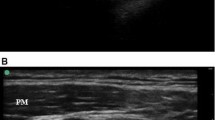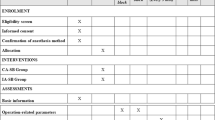Abstract
Objectives
To assess the adequacy of different amounts of local anesthetics (LA) in infraclavicular blockade (ICB) under ultrasonographic (US) guidance and neurostimulation and compare them to the conventional doses under neurostimulation (NS).
Material and methods
In this study 100 patients scheduled for upper limb surgery and suitable for ICB were randomly allocated to 1 of 5 groups: group NS (NS alone group 0.5 ml/kg LA), group FD (full-dose US group 0.5 ml/kg LA), group 30 (30 % reduced dose LA 0.35 ml/kg), group 50 (0.25 ml/kg LA) and group 70 (0.15 ml/kg LA). The ICB was performed under US in conjunction with NS in all groups except group NS in which neurostimulation was used alone. When necessary local anesthetic supplementation to the operation site was administered during surgery and propofol infusion for sedation ensued. Evaluation of sensory and motor block was performed for each terminal nerve (i.e. radial, ulnar, median and musculocutaneous nerves). Block quality (assessing the need for rescue LA and propofol sedation) and duration of the block were documented.
Results
None of the patients in the FD and 30 groups required any supplementation or sedation, whereas LA supplementation rates were 5 % in group 50 and 10 % in groups 70 and NS. The propofol sedation rates were 20 % in group NS, 25 % in group 50 and 40 % in group 70. Sensory block was significantly better in groups FD, 30 and NS at 30 min. A complete block was achieved more rapidly in all nerve territories in the full-dose group (p = 0.0001). Block duration was longest in group FD and was significantly longer in group 30 than in the other two groups (p = 0.0001).
Conclusion
The results show that US guidance is more effective in maintenance of successful ICB than neurostimulation guidance alone and a reduction of LA doses even to 70 % of conventionally used doses seems possible with US guidance.
This article is published in English.
Zusammenfassung
Ziele
Es sollten die Effekte unterschiedlicher Mengen an Lokalanästhetika während ultraschall- und nervenstimulationsgestützter infraklavikulärer Plexusblockade (ICB) im Vergleich zu den konventionellen Dosen unter alleiniger nervenstimulationsgestützter Blockade evaluiert werden.
Material und Methoden
Es wurden 100 Patienten in die Studie aufgenommen, die sich einem Eingriff an der oberen Extremität in peripherer Anästhesie des Plexus brachialis unterzogen. Die Patienten wurden in 5 Untersuchungsgruppen randomisiert: Gruppe NS [allein Nervenstimulator, 0,5 ml/kgKG Lokalanästhetika (LA)], Gruppe VD (Volle-Dosis-Ultraschall-Gruppe, 0,5 ml/kgKG LA), Gruppe 30 (um 30 % reduzierte LA-Dosis, 0,35 ml/kgKG), Gruppe 50 (0,25 ml/kgKG LA) und Gruppe 70 (0,15 ml/kgKG LA). In allen Gruppen, bis auf Gruppe NS, wurden eine ultraschallgesteuerte ICB und eine Nervenstimulation durchgeführt. In der Gruppe NS wurde eine ICB unter Nervenstimulation allein vorgenommen. Um die sensorischen und motorischen Blockaden zu beurteilen, wurden die 4 Hauptnerven (Nn. radialis, medianus, ulnaris und musculocutaneus) des Arms untersucht. Bei Bedarf wurden dem Patienten während des chirurgischen Eingriffs ergänzend LA oder Propofol zur Sedierung verabreicht. Die Blockqualität (unter Berücksichtigung des zusätzlichen Bedarfes an LA und Propofol Sedierung) und Wirkdauer wurden dokumentiert.
Ergebnisse
In den Gruppen VD und 30 wurde bei keinem Patienten ein Bedarf an ergänzendem LA oder Sedierung durch Propofol beobachtet. In Gruppe 50 konnte ein Bedarf an einer LA-Ergänzung bei 5 % sowie in den Gruppen 70 und NS bei 10 % der Patienten beobachtet werden. Der Bedarf an Sedierung durch Propofol betrug in der NS-Gruppe 20 %, in der 50-Gruppe 25 % und in der 70-Gruppe 40 %. Die sensorische Blockade in den Gruppen VD, 30 und NS war in der 30. Minute signifikant besser. Eine komplette Blockade aller Nervengebiete wurde in der VD-Gruppe am schnellsten erreicht (p = 0,0001). Die Blockadedauer war in der VD-Gruppe am längsten. In der Gruppe 30 ließ sich eine signifikant längere Blockadedauer als in den anderen beiden Gruppen ermitteln (p = 0,0001).
Schlussfolgerungen
Bei der erfolgreichen ICB-Durchführung ist die Steuerung durch Ultraschall im Vergleich zur Nervenstimulation effektiver und kann den Bedarf der LA-Menge bis zu 70 % der konventionellen Dosis reduzieren.

Similar content being viewed by others
References
Koscielniak-Nielsen ZJ, Frederiksen BS, Rasmussen H, Hesselbjerg L (2009) A comparison of ultrasound-guided supraclavicular and infraclavicular blocks for upper extremity surgery. Acta Anaesthesiol Scand 53(5):620–626
Gurkan Y, Hosten T, Tekin M et al (2012) Comparison of ultrasound-guided supraclavicular and infraclavicular approaches for brachial plexus blockade. Agri 24(4):159–164
Sandhu NS, Capan LM (2002) Ultrasound-guided infraclavicular brachial plexus block. Br J Anaesth 89:254–259
Desroches J (2003) The infraclavicular brachial plexus block by the coracoid approach is clinically effective: an observational study of 150 patients. Can J Anaesth 50:253–257
Jandard C, Gentili ME, Girard F et al (2002) Infraclavicular block with lateral approach and nerve stimulation: extent of anesthesia and adverse effects. Reg Anesth Pain Med 27:37–42
Liu SS, Ngeow J, John RS (2010) Evidence basis for ultrasound-guided block characteristics: onset, quality, and duration. Reg Anesth Pain Med 35(2):S26–S35. DOI 10.1097/AAP.0b013e3181d266f0
Dingemans E, Williams SR, Arcand G et al (2007) Neurostimulation in ultrasound-guided infraclavicular block: a prospective randomized trial. Anesth Analg 104(5):1275–1280
Borgeat A, Ekatodramis G, Dumont C (2001) An evaluation of the infraclavicular block via a modified approach of the Raj technique. Anesth Analg 93:436–441
Ootaki C, Hayashi H, Amano M (2000) Ultrasound-guided infraclavicular brachial plexus block: an alternative technique to anatomical landmark-guided approaches. Reg Anesth Pain Med 25:600–604
Marhofer P, Schrögendorfer K, Koinig H et al (1997) Ultrasonographic guidance improves sensory block and onset time of three-in-one blocks. Anesth Analg 85:854–857
Williams SR, Chouinard P, Arcand G et al (2003) Ultrasound guidance speeds execution and improves the quality of supraclavicular block. Anesth Analg 97:1518–1523
Marhofer P, Schrogendorfer K, Wallner T et al (1998) Ultrasonographic guidance reduces the amount of local anesthetic for 3-in-1 blocks. Reg Anesth Pain Med 23:584–588
Casati A, Baciarello M, Di Cianni S et al (2007) Effects of ultrasound guidance on the minimum effective anaesthetic volume required to block the femoral nerve. Br J Anaesth 98:823–827
Valery P, Aliaksei M (2013) A comparison of the onset time of complete blockade of the sciatic nerve in the application of ropivacaine and its equal volumes mixture with lidocaine: a double-blind randomized study. Korean J Anesthesiol 65(1):42–47
Laur JJ, Bayman EO, Foldes PJ, Rosenquist RW (2012) Triple-blind randomized clinical trial of time until sensory change using 1.5 % mepivacaine with epinephrine, 0.5 % bupivacaine, or an equal mixture of both for infraclavicular block. Reg Anesth Pain Med 37(1):28–33
Keckeis A, Hofmockel R (1994) Mixtures of different local anesthetics for subaxillary plexus anesthesia. Anaesthesiol Reanim 19(2):32–36
Tryba M, Börner P (1988) Clinical effectiveness and systemic toxicity of various mixtures of prilocaine and bupivacaine in axillary plexus block. Reg Anaesth 11(2):40–49
Chan VW, Perlas A, Rawson R, Odukoya O (2003) Ultrasound-guided supraclavicular brachial plexus block. Anesth Analg 97:1514–1517
Marhofer P, Sitzwohl C, Greher M, Kapral S (2004) Ultrasound guidance for infraclavicular brachial plexus anaesthesia in children. Anaesthesia 59:642–646
Tran De QH, Charghi R, Finlayson RJ (2006) The “double bubble” sign for successful infraclavicular brachial plexus blockade. Anesth Analg 103(4):1048–1049. DOI 10.1213/01.ane.0000239077.49794.a5
Tran De QH, Bertini P, Zaouter C et al (2010) A prospective, randomized comparison between single- and double-injection ultrasound-guided infraclavicular brachial plexus block. Reg Anesth Pain Med 35:16–21
Desgagnés MC, Lévesque S, Dion N et al (2009) A comparison of a single or triple injection technique for ultrasound-guided infraclavicular block: a prospective randomized controlled study. Anesth Analg 09:668–672
Retzl G, Kapral S, Greher M, Mauritz W (2001) Ultrasonographic findings of the axillary part of the brachial plexus. Anesth Analg 92:1271–1275
Becker DE, Reed KL (2006) Essentials of local anesthetic pharmacology. Anesth Prog 53:98–108
Mather LE, Copeland SE, Ladd LA (2005) Acute toxicity of local anesthetics: underlying pharmacokinetic and pharmacodynamic concepts. Reg Anesth Pain Med 30:553–566
Ponrouch M, Bouic N, Bringuier S et al (2010) Estimation and pharmacodynamic consequences of the minimum effective anesthetic volumes for median and ulnar nerve blocks: a randomized, double-blind, controlled comparison between ultrasound and nerve stimulation guidance. Anesth Analg 111:1059–1064
Sandhu NS, Bahniwal CS, Capan LM (2006) Feasibility of an infraclavicular block with a reduced volume of lidocaine with sonographic guidance. J Ultrasound Med 25:51–56
Tran De QH, Dugani S, Dyachenko A et al (2011) Minimum effective volume of lidocaine for ultrasound-guided infraclavicular block. Reg Anesth Pain Med 36:190–194
Fredrickson MJ, Smith KR, Wong AC (2010) Importance of volume and concentration for ropivacaine interscalene block in preventing recovery room pain and minimizing motor block after shoulder surgery. Anesthesiology 112:1374–1381
Duggan E, El Beheiry H, Perlas A et al (2009) Minimum effective volume of local anesthetic for ultrasound-guided supraclavicular brachial plexus block. Reg Anesth Pain Med 34:215–218
Flohr-Madsen S, Ytrebø LM, Kregnes S et al (2013) Minimum effective volume of ropivacaine 7.5 mg/ml for an ultrasound-guided infraclavicular brachial plexus block. Acta Anaesthesiol Scand 57(4):495–501. DOI 10.1111/aas.12078
Acknowledgments
We would like to acknowledge Konyalioglu R. (Bakirkoy Dr Sadi Konuk Training Hospital, Biostatistics) for consultation on the statistical analyses used in this study.
Compliance with ethical guidelines
Conflict of interest. G. Eren, E. Altun, Y. Pektas, Y. Polat, H. Cetingok, G. Demir, D. Bilgi, Y. Tekdos und M. Dogan state that there are no conflicts of interest. All studies on humans described in the present manuscript were carried out with the approval of the responsible ethics committee and in accordance with national law and the Helsinki Declaration of 1975 (in its current, revised form). Informed consent was obtained from all patients included in studies.
Author information
Authors and Affiliations
Corresponding author
Rights and permissions
About this article
Cite this article
Eren, G., Altun, E., Pektas, Y. et al. To what extent can local anesthetics be reduced for infraclavicular block with ultrasound guidance?. Anaesthesist 63, 760–765 (2014). https://doi.org/10.1007/s00101-014-2361-4
Received:
Revised:
Accepted:
Published:
Issue Date:
DOI: https://doi.org/10.1007/s00101-014-2361-4




